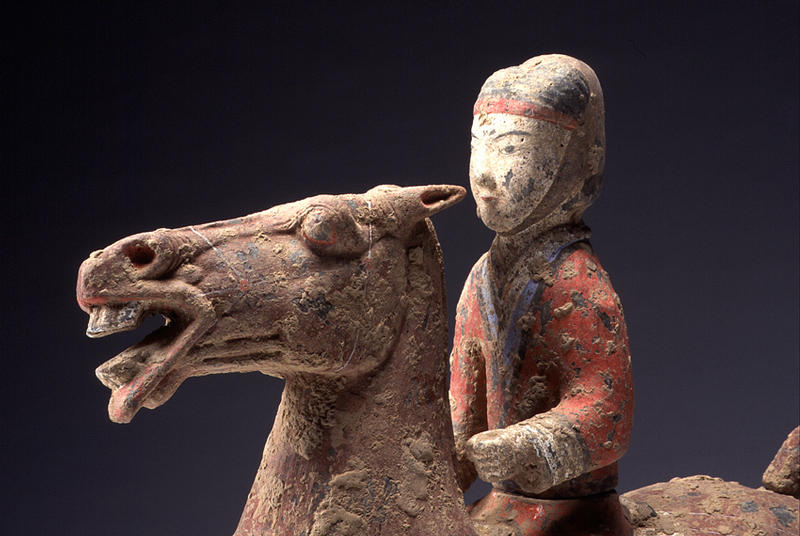騎兵俑
- 中国
- 前漢時代
- 前206-後9年
- 土器に着彩
- H-59.5 D-49 W-18.3
中国は最初、武装した騎兵の着想を、戦国時代、北方の国境地方に居住していた遊牧民から獲得した。前漢時代に伝説で名高い「天馬」がフェルガナ地方、烏孫から獲得されたが、中国自体それまでは優良な品種の馬を有していなかった。これらの背の高く足の速い動物は、短い脚、分厚い体躯、太い頸をもつ中国の固有種よりもはるかに優れていると見なされた。実際、新しい「汗血」馬は、中国の北方の遊牧民の連合との絶え間ない戦争に不可欠のものとなった。そして、それらの特異な身体的特徴がこの騎兵の陶俑に例証されている。この幅広く力強い胸部、真っ直ぐな頸、突き出た眼、そして開いた口をもち、活動的な外観を呈する陶製の馬は、前王朝の皇帝である秦の始皇帝の墓穴で発見されたおとなしそうな、頑丈な像とは非常に異なるものである。この馬の上には姿勢を正し、真っ直ぐなズボンと丈の短い数枚の襟を合わせた短い上着を身につけた兵士が鞍の上に座す。兵士は両手を開いている。兵士の左手は手綱を握るかのように挙げられ、より低い位置にある右手は武器を持つかのように形作られている。馬と騎手は各々一連の型から製造されている。鞍や兵士の下半身など、いくつかは焼成の前に付けられている。兵士の上半身や馬の尻尾など、他のものは焼成の後に加えられている。馬具は馬の体躯の上に黒色、白色、そして赤色の顔料で描かれている。赤色はまた馬の唇と鼻孔、そして内耳を彩色する。騎手の顔の造作と頭髪は黒色で描かれ、帽子は茶色に、鉢巻きと丈の短い上着は赤色が塗られている。スミレ色の襟の折り返しの飾りは兵士の丈の短い上着を補完し、また帯は黒く塗られている。
Catalogue Entry
Although China first took the idea of an armed cavalry from nomads living on its northern borders during the Warring States period, China itself did not possess a superior breed of horse until the Western Han dynasty, when the fabled "celestial horses" were procured from the Wusun, a pastoral people living in the region of Ferghana.1 These tall, fast animals were considered far superior to China's indigenous breed with its short legs, thick bodies, and broad necks. Indeed, the new "blood-sweating" horses became essential in China's continuous warfare against the northern nomadic confederacy, and their unique physical characteristics are illustrated in this tomb figure of a cavalryman and the bronze horse in the next entry (cat. no. 117).
This dynamic-looking ceramic horse, with its broad, powerful chest, straight neck, protruding eyes, and open mouth, is very different from the placid, sturdy images found in the tomb pits of the previous dynasty's emperor, Qin Shihuangdi. On this horse, an erect soldier, dressed in several overlapping tunics and a pair of straight pants, is seated upon a saddle. Both of the warrior's hands have openings: his left hand is raised as if he were holding the reins; his lower right hand is fashioned to hold a weapon. Horse and rider were both created out of a series of molded pieces. Some were attached before firing, such as the saddle and lower portion of the soldier's body; others were added after firing, such as the upper portion of the warrior's body and the horse's tail. Horse fittings have been painted onto the body of the horse in black, white and red pigments. Red also colors the horse's lips, nostrils, and inner ears. The rider's facial features and hair are painted in black, his cap colored brown, and his headband and tunic painted red. A violet lapel trim complements his tunic, which also features a black painted belt.
The Shumei warrior-and-horse tomb figure is stylistically similar to those found in the tombs at Yangjiawan, Xianyang, Shaanxi province, in 1965, which are believed to have belonged to a Western Han prime minister Zhou Bo and his son Zhou Yafu.2 Within these tombs, the ceramic, painted cavalry acted as a rear guard behind the foot soldiers. The Shumei and Yangjiawan cavalry tomb figures confirm the importance of the cavalry and reflect the type of military uniforms and horse fittings popular during the Western Han dynasty.
JMS
1. Warfare during the early Warring States period was dominated by chariots. Later the use of chariots, which had always been difficult to maneuver, diminished as the advantages of a more flexible infantry were realized. By the end of the fourth century B.C., the Chinese had learned from the Xiongnu the advantages of mounted archers to supplement the infantry. For more information see Bodde 1986, pp. 24-25.
2. These tombs date from the reigns of emperors Wendi (179-157 B.C.) and Jingdi (156-141 B.C.). Also see Wenwu 1966.3, pp. 1-5; Wenwu 1977.10, pp. 10-12; Hong Kong Urban Council, 1993, p. 52.
3. Wang 1987, p. 47.

